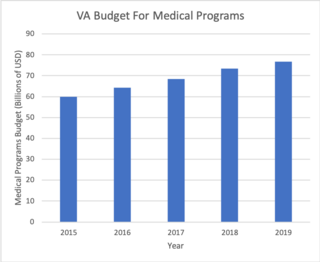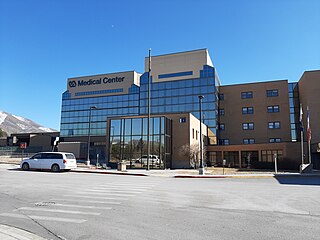
The Veterans Health Administration (VHA) is the component of the United States Department of Veterans Affairs (VA) led by the Under Secretary of Veterans Affairs for Health that implements the healthcare program of the VA through a nationalized healthcare service in the United States, providing healthcare and healthcare-adjacent services to veterans through the administration and operation of 146 VA Medical Centers (VAMC) with integrated outpatient clinics, 772 Community Based Outpatient Clinics (CBOC), and 134 VA Community Living Centers Programs. It is the largest division in the department, and second largest in the entire federal government, employing over 350,000 employees. All VA hospitals, clinics and medical centers are owned by and operated by the Department of Veterans Affairs, and all of the staff employed in VA hospitals are federal employees. Because of this, veterans that qualify for VHA healthcare do not pay premiums or deductibles for their healthcare but may have to make copayments depending on the medical procedure. VHA is not a part of the US Department of Defense Military Health System.

Massachusetts General Hospital is the original and largest teaching hospital of Harvard Medical School, Harvard University located in the West End neighborhood of Boston, Massachusetts. Massachusetts General Hospital houses the world's largest hospital-based research program, the Mass General Research Institute, with an annual research budget of more than $1.2 billion in 2021. It is the third-oldest general hospital in the United States with a patient capacity of 999 beds. Along with Brigham and Women's Hospital, Mass General is a founding member of Mass General Brigham, formerly known as Partners HealthCare, the largest healthcare provider in Massachusetts.

Rush University Medical Center (Rush) is an academic medical center in the Illinois Medical District neighborhood of Chicago, Illinois. It is the flagship hospital for the Rush University System for Health, which includes Rush Oak Park Hospital and Rush Copley Medical Center, and serves as the primary teaching hospital in affiliation with Rush University.

The Madigan Army Medical Center, located on Joint Base Lewis-McChord just outside Lakewood, Washington, is a key component of the Madigan Healthcare System and one of the largest military hospitals on the West Coast of the United States.
Spartanburg Regional Healthcare System(SRHS) is one of South Carolina's largest healthcare systems. SRHS draws patients primarily from the areas of Spartanburg, Cherokee, Union, and Greenville counties (all located in the Piedmont region of South Carolina) as well as Rutherford and Polk counties (located in western North Carolina). Spartanburg General Hospital was organized under the authority of the South Carolina General Assembly in 1917 and officially became the Spartanburg Regional Health Services District, Inc., a political subdivision of the State of South Carolina, by the charter granted by the secretary of state of South Carolina on May 1, 1995.

Atrium Health Floyd is a system of health care providers serving Northwest Georgia and Northeast Alabama since 1942. Located in Rome, Georgia, it is Floyd County’s largest employer with over 3,400 employees. It is a part of the Atrium Health system.
The President's Commission on Care for America's Returning Wounded Warriors, also known as the Dole-Shalala Commission, was established on March 6, 2007, when U.S. President George W. Bush signed Executive Order 13426. The Commission was established to examine and recommend improvements to the effectiveness and quality of transition from returning to military service or civilian society, health care, benefits, outreach to service members, and awareness among service members of healthcare and benefits programs.

Lexington Veterans Affairs Medical Center, located in Lexington, Kentucky, is 199 bed medical facility owned by the United States Department of Veterans Affairs. The Lexington Veterans Affairs Medical Center is a fully accredited, two-division, tertiary care medical center with an operating bed complement of 199 hospital beds. Acute medical, neurological, surgical and psychiatric inpatient services are provided at the Cooper Division, located adjacent to the University of Kentucky Medical Center. Other available services include: emergency care, medical-surgical units, acute psychiatry, ICU, progressive care unit, ambulatory surgery, OR/PACU, hemodialysis, medicine specialty clinics, surgery specialty clinics, and outpatient primary and specialty care.

Emory Healthcare is a health care system in the U.S. state of Georgia. It is part of Emory University and is the largest healthcare system in the state. It comprises 11 hospitals, the Emory Clinic and more than 250 provider locations. Established in 2011, the Emory Healthcare Network is the largest clinically integrated network in Georgia with more than 2,800 physicians concentrating in 70 different subspecialties.

Wounded Warrior Project (WWP) is an American charity and veterans service organization that operates as a nonprofit 501(c)(3). WWP offers a variety of programs, services and events for wounded veterans who incurred a physical or mental injury, illnesses, or co-incident to their military service on or after September 11, 2001. Military family members and caregivers are also eligible for WWP programs.
Sharp Grossmont Hospital is located in La Mesa, California, United States. It is the largest healthcare facility in East San Diego County with a service area covering 750 square miles. The property is owned by Grossmont Healthcare District, which has leased it to Sharp HealthCare since 1991. Sharp HealthCare, however, manages all hospital operations as a separate entity.
The Defense Centers of Excellence for Psychological Health and Traumatic Brain Injury (DCoE) is a United States Department of Defense (DoD) organization that provides guidance across DoD programs related to psychological health (PH) and traumatic brain injury (TBI) issues. The organization's official mission is to "improve the lives of our nation’s service members, families and veterans by advancing excellence in psychological health and traumatic brain injury prevention and care."
The Naval Center for Combat and Operational Stress Control (NCCOSC) is a U.S. Navy Medicine organization established to promote psychological health in the U.S. Navy and Marine Corps. It is a culturally relevant center that leverages sound medical knowledge to improve resilience, preserve psychological health, improve care for sailors, marines and their families and facilitate Navy Medicine research efforts on psychological health and traumatic brain injury.
UCLA Operation Mend is a medical partnership established in October 2007 between Ronald Reagan UCLA Medical Center, Brooke Army Medical Center in San Antonio, Texas, and the V.A.-Greater Los Angeles Healthcare System that provides reconstructive surgery to U.S. military personnel that have been severely wounded during service in Iraq and Afghanistan. The project aims to serve as a model for other medical institutions interested in helping wounded service members.
The United States Department of Veterans Affairs (VA) Central Western Massachusetts Healthcare System is a health care organization that provides care to Massachusetts’ Veterans. It is part of the VA New England Healthcare System, one of 21 Veterans Integrated Service Networks (VISNs) within the VA. The VA New England Healthcare System includes VA medical centers in Boston and all six New England states. The VA Central Western Massachusetts Healthcare System includes a medical center in Northampton and community-based outpatient clinics (CBOCs) in Greenfield, Worcester, Pittsfield, Springfield and Fitchburg.
The National Center for Telehealth & Technology (T2) is one of the Defense Centers of Excellence for Psychological Health and Traumatic Brain Injury (DCoE), a part of the Military Health System (MHS). T2 was originally established to lead the integration of behavioural sciences with technology to provide solutions for psychological health and traumatic brain injury (TBI). T2 is a principal coordinator of United States Department of Defense (DoD) initiatives involving telehealth, online health tools, suicide surveillance and prevention, and information technology.
The Center for Deployment Psychology (CDP) is an organization offering training for behavioral health professionals who provide mental health services unique to the experience of deployment in the United States Armed Forces for active-duty military service members, veterans and their families. CDP is headquartered at the Uniformed Services University of the Health Sciences (USUHS) in Bethesda, Maryland, and is funded by the United States Department of Defense.
UCLA Health is the public healthcare system affiliated the University of California, Los Angeles, located in Los Angeles, California. It comprises a number of hospitals, UCLA David Geffen School of Medicine, and an extensive primary care network in the Los Angeles region.

The Minneapolis Veterans Affairs Health Care System (VAHCS) is network of hospital and outpatient clinics based in Minneapolis, Minnesota, USA. It belongs to the VISN23 VA Midwest Health Care Network managed by the Veterans Health Administration of the Department of Veterans Affairs. The Minneapolis VAHCS provides healthcare for United States military veterans in areas such as medicine, surgery, psychiatry, physical medicine and rehabilitation, neurology, oncology, dentistry, geriatrics and extended care. As a teaching hospital, it operates comprehensive training programs for multiple treatment specialties. The Minneapolis VAHCS also hosts one of the largest research programs of any VA health care system and maintains research affiliations with the University of Minnesota.

The George E. Wahlen Veterans Affairs Medical Center (VAMC) is located in Salt Lake City, Utah, and is a part of the VA Salt Lake City Healthcare System. The George E. Wahlen VA Hospital is a 121-bed short-term acute care hospital and is designated as a medical training and research facility. For the scale of operations in 2021, the George E. Wahlen VA had 2,739 employees, treated 72,303 veterans, and accommodated nearly 703,109 outpatient visits. As of 2021, of the veterans treated here, 31,786 served in the Persian Gulf, 27,029 served in the Vietnam War, 803 in World War II, 2,911 served in the Korean War, and 5,519 were women. During 2021, the George E. Wahlen VA federal budget allocation was over $743 million. The George E. Wahlen Medical Center is one of only five Veterans Affairs heart transplant centers in the United States. The facility is encompassed within the Veterans Integrated Service Network 19 within the Rocky Mountain Region.










